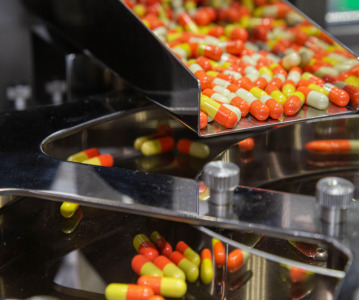Bosch launches new WFI system at interpack

WFI production using membrane processes.
Efficient alternative to distillation.
At interpack 2017, Bosch will present its new system for the production of water for injection (WFI). As the name implies, first and foremost WFI is used in solutions for injection and infusion, making it a key component in pharmaceutical manufacturing. To date, it was only possible to produce WFI for the European market using distillation. However, as of 1 April 2017, the revised European Medicine Agency (EMA) Pharmacopeia allows, for the first time, WFI to be obtained using other comparable processes. “Our generation unit is specially designed to meet the EMA requirements,” explains Dr John Medina, Sales Manager at the Bosch subsidiary Pharmatec, which developed the unit.
WFI production using membrane processes
The generation unit employs the 'cold' membrane processing methods reverse osmosis and electrodeionization, together with an additional ultrafiltration step. Reverse osmosis is a physical filtration process that removes ions from the water, and the subsequent electrodeionization further reduces the remaining salt content through a combination of ion exchange and electrodialysis. The unit’s ultrafiltration module then separates out particles such as microbes and pyrogens on the basis of their weight and molecular size. Until now, in the European Union this method was only approved for the production of highly purified water (HPW), whereas in the US and Japan it has already been approved for obtaining WFI. In the future, the process will also be permitted by European authorities – albeit with additional, specific requirements.
Offering both thermal and chemical sanitization
Essentially, the unit must produce water under conditions that prevent the growth of micro-organisms and other impurities. For reverse osmosis systems, the EMA stipulates regular sanitization of the unit using hot water – primarily to prevent the formation of biofilms. Biofilms are caused by microbes, such as bacteria, and are difficult to remove from industrial systems. For additional protection, chemical sanitization must also be an option.
According to Medina: “The unit on display at interpack allows routine thermal sanitization. When it comes to hot water sanitization, temperatures of 85 degrees Celsius can be reached.” In addition, the EMA recommends chemical sanitization using ozone, to minimize the risk of microbial contamination. The unit offers this option as well. To prevent contamination as a result of insufficient barrier properties, the membranes’ integrity is checked on a regular basis.
Bosch has now reworked the WFI unit, including a more hygienic design and built-in measuring technology to monitor the system. The stainless steel used in the storage and distribution systems does not affect the water quality. Further, the system allows all the components to be thermally sanitized at any time.
Process monitoring is essential for water quality
“Monitoring all the processes in the production chain is essential to guaranteeing the microbial quality of the water,” says Medina, “which is why we fitted the unit with various sensors and measuring devices to monitor the water quality throughout the process and to check the individual steps.” Total organic carbon (TOC) is a key indicator of the water’s quality, and since it is also a parameter for the risk of microbial contamination in the overall system, it has to be continually monitored. Conductivity is another important parameter, and here the EMA stipulates inline process control. The unit is equipped with an online measuring system to monitor specific conductivity. To routinely test the water in real time, Bosch has also installed an online microbe counter, which continuously records and quantifies the level of microbes and inert particles using light-induced fluorescence measurements and algorithms. All parameters are centrally monitored and controlled by means of an intuitive interface.
Related News
-
News Pharmapack Awards 2024 Patient-Centric Design Award Winner – Dr Ferrer BioPharma
The 2024 Pharmapack Awards celebrated the best in innovation and design for the pharmaceutical packaging and drug delivery industry on January 24, 2024. -
News Women in Pharma: Minding the Gap at Pharmapack 2024
2024 marks the first year Pharmapack will host a Diversity track dedicated to bridging the gap within the pharmaceutical packaging and drug delivery sector. The track includes a panel discussion on 'Enabling Diversity in the Workplace,' focused... -
News Pharmapack Awards 2024 - Celebrating Packaging and Drug Delivery Innovation
The 2024 Pharmapack Innovation Awards ceremony celebrated the best in pharmaceutical packaging and drug delivery innovation at all levels. The awards were held on January 24, 2024 at the Paris Expo Porte de Versailles. -
News Pharmapack 2024 - From the Floor
Paris once again welcomes Europe’s leading trade show in pharmaceutical packaging and drug delivery innovation. Join our content team as Pharmapack 2024 opens its doors to leading experts and innovators in pharmaceutical packaging and drug delive... -
News CPHI Barcelona 2023: Partnering for Success – Managing Outsourcing Relationships to Optimise Manufacturing Operations
During CPHI Barcelona 2023, insightful content sessions offered attendees the chance to explore trending topics with expert speakers and panellists. Here, we summarise what the pharma industry and supply chain are talking about the most. -
News CPHI Barcelona 2023: Loading Potential – Artificial Intelligence for Pharma Manufacturing
During CPHI Barcelona 2023, insightful content sessions offered attendees the chance to explore trending topics with expert speakers and panellists. Here, we summarise what the pharma industry and supply chain are talking about the most. -
News Pharmaceutical industry supports COP28 health stance in joint statement
As COP28 takes place over this week in Dubai, UAE, several bodies in the pharmaceutical and health industries have come together to announce support of key movements in sustainability in the sector, and to recognise sustainability as a health issue.&nb... -
News CPHI Podcast Series: Start-ups take centre stage at CPHI Barcelona
The first episode of the CPHI Podcast Series since we attended CPHI Barcelona in October covers the Start-up market at the event, with expert Matthew Wise joining Editor Lucy Chard to discuss the event.
Position your company at the heart of the global Pharma industry with a CPHI Online membership
-
Your products and solutions visible to thousands of visitors within the largest Pharma marketplace
-
Generate high-quality, engaged leads for your business, all year round
-
Promote your business as the industry’s thought-leader by hosting your reports, brochures and videos within your profile
-
Your company’s profile boosted at all participating CPHI events
-
An easy-to-use platform with a detailed dashboard showing your leads and performance





.png)

